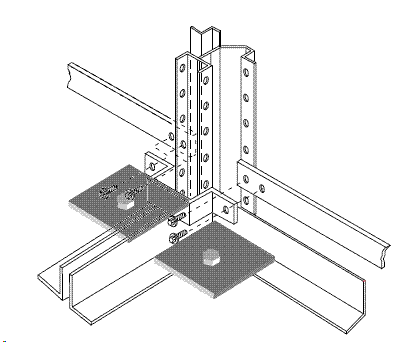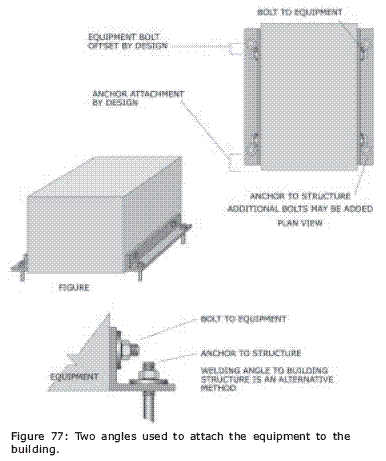You are using an out of date browser. It may not display this or other websites correctly.
You should upgrade or use an alternative browser.
You should upgrade or use an alternative browser.
anchoring switchgear
- Thread starter mcelweec@gmail.com
- Start date
- Status
- Not open for further replies.
- Location
- Bremerton, Washington
- Occupation
- Master Electrician
The AB MCCs I have installed require 4 1/2" grade 5 anchors on the ends and two anchors in the middle. The last two jobs contractors used 3/8" expansion anchors, the project manager bought off on it. I had gone so far to put the AB detail in the drawings.
Once the gear is installed its too late.
One simple way to install is to set the gear, mark the holes, move the gear, drill the holes, reset the gear, and use epoxy anchor studs. Shoot the epoxy into the holes with the gear in place. Then insert the anchors, let cure and fasten.
Once the gear is installed its too late.
One simple way to install is to set the gear, mark the holes, move the gear, drill the holes, reset the gear, and use epoxy anchor studs. Shoot the epoxy into the holes with the gear in place. Then insert the anchors, let cure and fasten.
weressl
Esteemed Member
first post.i have a line of switchgear, consisting of 2000a utility section,2000a mcb, and two section distribution.This line is 15ft long and weighs in excess of 6,000lbs.The ahj is questioning anchoring requirements for this equipment.
My question is,is freestanding equipment required to be anchored .Btw i am working in NJ and the ahj are unbelievably meticulous so code references are appreciated.BTW this came up today[saturday] and hinged on a cut card .
Switchgear installation instructions will include the anchoring requirements. Different requirements for anchoring are based on seismic rating of the gear itself and should be followed to retain the seismic rating of the equipment. The equipment short circuit withstand rating also relies on the appropriate bracing, fastening securing the equipment to each other and to the supporting means.
mcelweec@gmail.com
CMAC1
- Location
- NYC
- Occupation
- Electrician
vod-vil its probably going to be thursday before i can get specs to you.Right now i can tell you ,its a pse&g 2000a ct meter cab ,2000a siemens mcb cab and 2section distribution cab. these are open bottom cabinets with "c"framing.I have very capable guys on site who cannot figure out how to anchor this gear without resorting to a kindorlf catalog.I did look at the install last year ,when it was approved,but couldn't figure out how to anchor it either.
vod-vil its probably going to be thursday before i can get specs to you.Right now i can tell you ,its a pse&g 2000a ct meter cab ,2000a siemens mcb cab and 2section distribution cab. these are open bottom cabinets with "c"framing.I have very capable guys on site who cannot figure out how to anchor this gear without resorting to a kindorlf catalog.I did look at the install last year ,when it was approved,but couldn't figure out how to anchor it either.
As an example, Siemens SENTRON™ Switchboards Types SB1, SB2, SB3 and RCIII Instruction & Installation Guide. Refer to the first part of Section 4.
mcelweec@gmail.com
CMAC1
- Location
- NYC
- Occupation
- Electrician
i have read the sentron series installation instructions and they do indicate anchoring points on cubicle bottom.however i have a bottomless sb-3 line up with no mounting provisions on the cabinet framing.
mcelweec@gmail.com
CMAC1
- Location
- NYC
- Occupation
- Electrician
check out figure 13,this is an example of the framing detail
.however i have a bottomless sb-3 line up with no mounting provisions on the cabinet framing.
Intresting- so if the factory has not providing provisions for securing this gear, does that mean its listing does NOT require it to be secured?
i have read the sentron series installation instructions and they do indicate anchoring points on cubicle bottom.however i have a bottomless sb-3 line up with no mounting provisions on the cabinet framing.
I'm getting the impression that the factory anchoring method was integral with the section bottoms and removed by the factory.
If this is the case, I'd shoot off an RFI through whatever routing necessary to get a factory/manufacturer recommendation.
My recommendation would be to cut 4"?4"?1/4" steel plates out of strap stock, drill a 1/2" hole in the center, paint them, place tight against the inside corner of each section, and fasten down with a wedge anchor.
mcelweec@gmail.com
CMAC1
- Location
- NYC
- Occupation
- Electrician
smart $,should be my responsibility
e57
Senior Member
- Location
- San Francisco, CA
Not so sure this is a good method - the slightest shift would bend or jar the plates out of place - leaving you with floating gear. The manufaturer must have some required specific accessory clips, angles or strut mounting for the purpose - otherwise I would suggest welding the plates on. Better yet welding/bolting angles to the outside bottom of the gear. Check out that FEMA link again.I'm getting the impression that the factory anchoring method was integral with the section bottoms and removed by the factory.
If this is the case, I'd shoot off an RFI through whatever routing necessary to get a factory/manufacturer recommendation.
My recommendation would be to cut 4"?4"?1/4" steel plates out of strap stock, drill a 1/2" hole in the center, paint them, place tight against the inside corner of each section, and fasten down with a wedge anchor.
quogueelectric
Senior Member
- Location
- new york
Just take the bottom covers off with a screwgun and drill some steel anchors into the concrete through the holes in the gear. Couple of hex bolts couple of washers and you are done. Should take a mechanic less then 2 hrs complete.
It's gonna take major seismic activity to shift gear that's pinned down at every inside corner with 1/4" plate. The anchors would likely be pulled out of the concrete before the plates give way. And if 1/4" plate won't do it, they can always be beefed up to 3/8" plate and 5/8" anchors... but I believe that to be overkill (for the area).Not so sure this is a good method - the slightest shift would bend or jar the plates out of place - leaving you with floating gear.

The manufacturer seemingly makes the anchoring provisions integral to the bottom cover, which they likely removed when the gear was ordered open-bottom. Yet I have to ask how the factory secured it to the shipping pallets???The manufaturer must have some required specific accessory clips, angles or strut mounting for the purpose - otherwise I would suggest welding the plates on. Better yet welding/bolting angles to the outside bottom of the gear. Check out that FEMA link again.
One thought I did have is whether there is sufficient clearance to facilitate inside anchoring. Barring such space, I would go with the outside angle method. I prefer full length of gear, rather than short sections, as it just looks better, IMO. From FEMA document you linked above....

mcelweec@gmail.com
CMAC1
- Location
- NYC
- Occupation
- Electrician
thanks for all the replies ,the ahj is willing to accept knee brackets bolted to the equipment
e57
Senior Member
- Location
- San Francisco, CA
IMO it doesn't take much in a quake to get things moving. Nice sketch-up...It's gonna take major seismic activity to shift gear that's pinned down at every inside corner with 1/4" plate. The anchors would likely be pulled out of the concrete before the plates give way. And if 1/4" plate won't do it, they can always be beefed up to 3/8" plate and 5/8" anchors... but I believe that to be overkill (for the area).

The above method is far superior - bolts going through things, no opprotunity for slipage. Even if it were to deform it would need to draw the bolt through the angle or just shear off. Not to mention it would be much easier to do.One thought I did have is whether there is sufficient clearance to facilitate inside anchoring. Barring such space, I would go with the outside angle method. I prefer full length of gear, rather than short sections, as it just looks better, IMO. From FEMA document you linked above....

I don't totally disagree with your viewpoint. However, I'm basing my method on experience with anchoring this particular type of enclosure using the manufacturer's method, i.e. through the bottom cover plate. Their holes aren't even close to the corners... usually about 6?8" in from both sides... and the cover, which I do not believe to be tempered steel, is substantially thinner than 1/4".IMO it doesn't take much in a quake to get things moving. Nice sketch-up...Anyway - depending on the plate - anchorning plates that are tempered are one thing.... But if you made them yourself out of mild steel IMO 1/4" would bend way too easy - if not the bracket angle of the frame.
- Status
- Not open for further replies.
